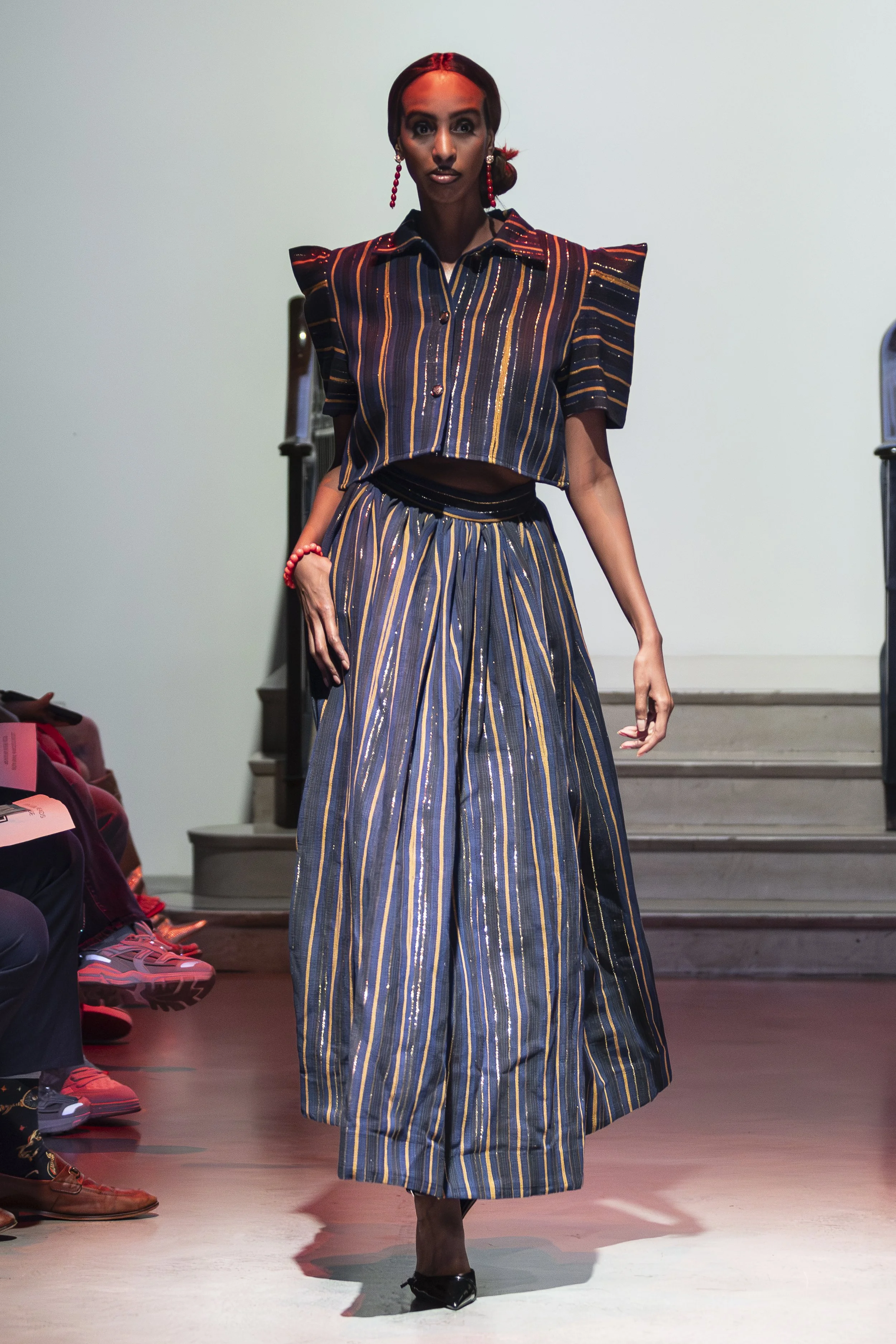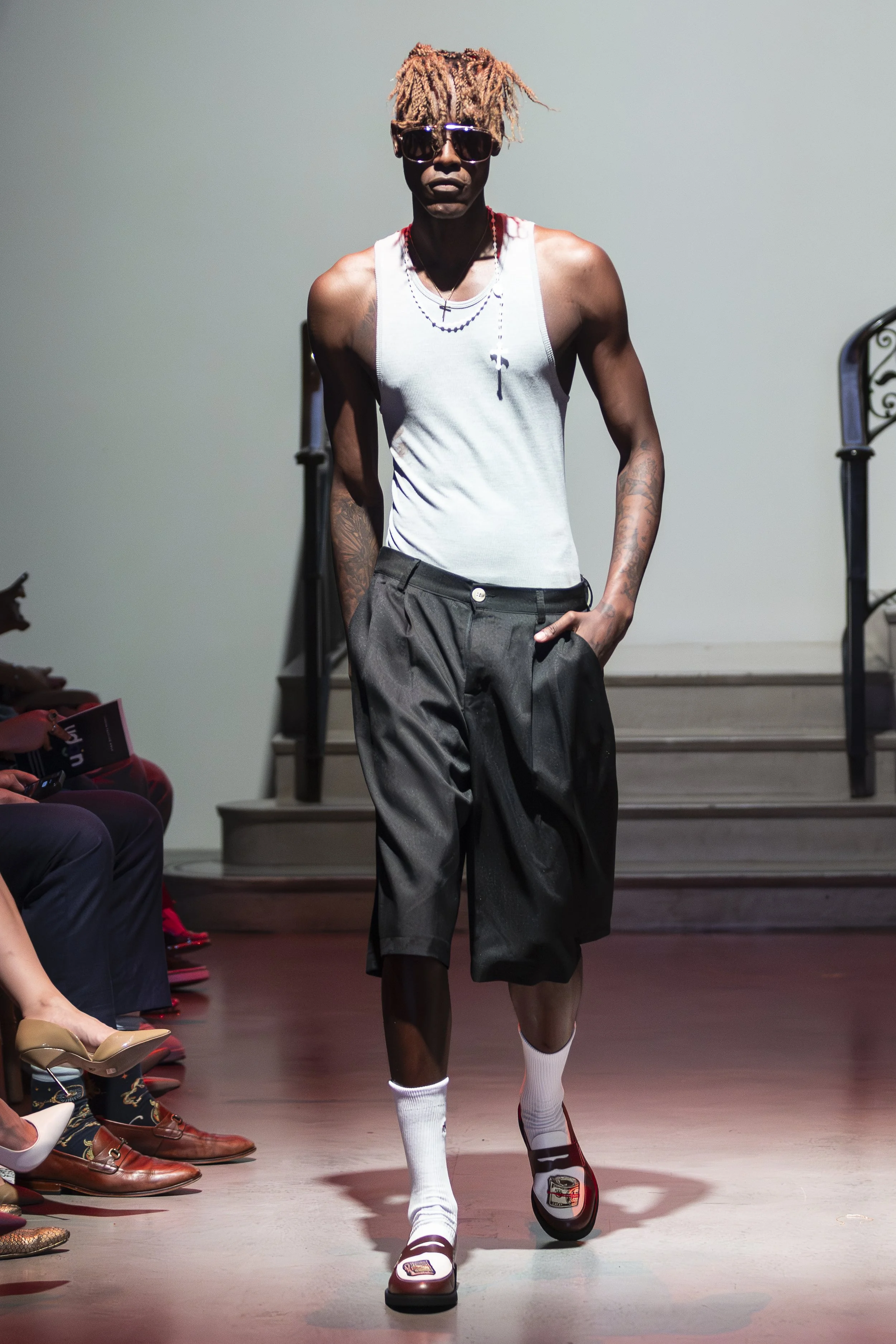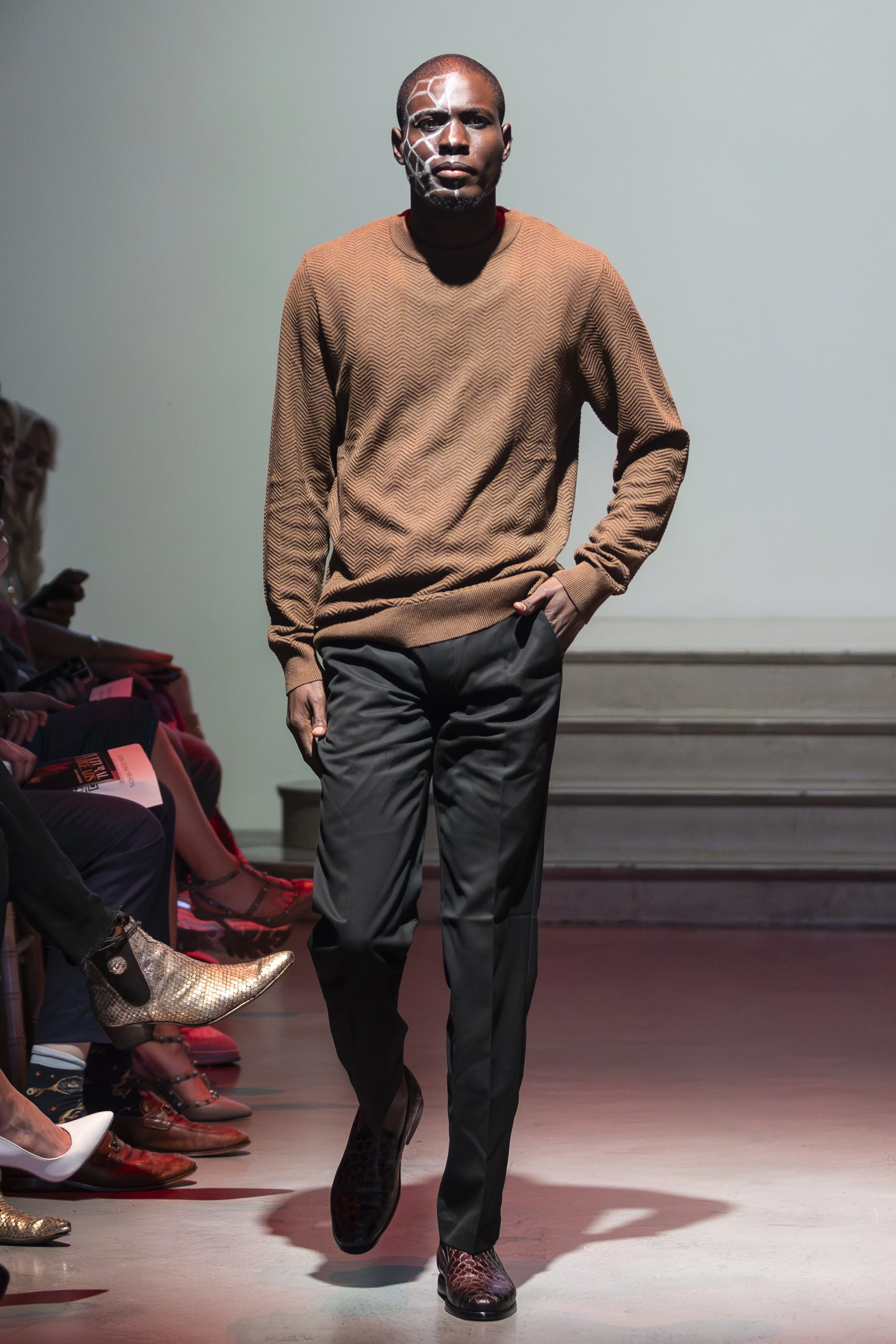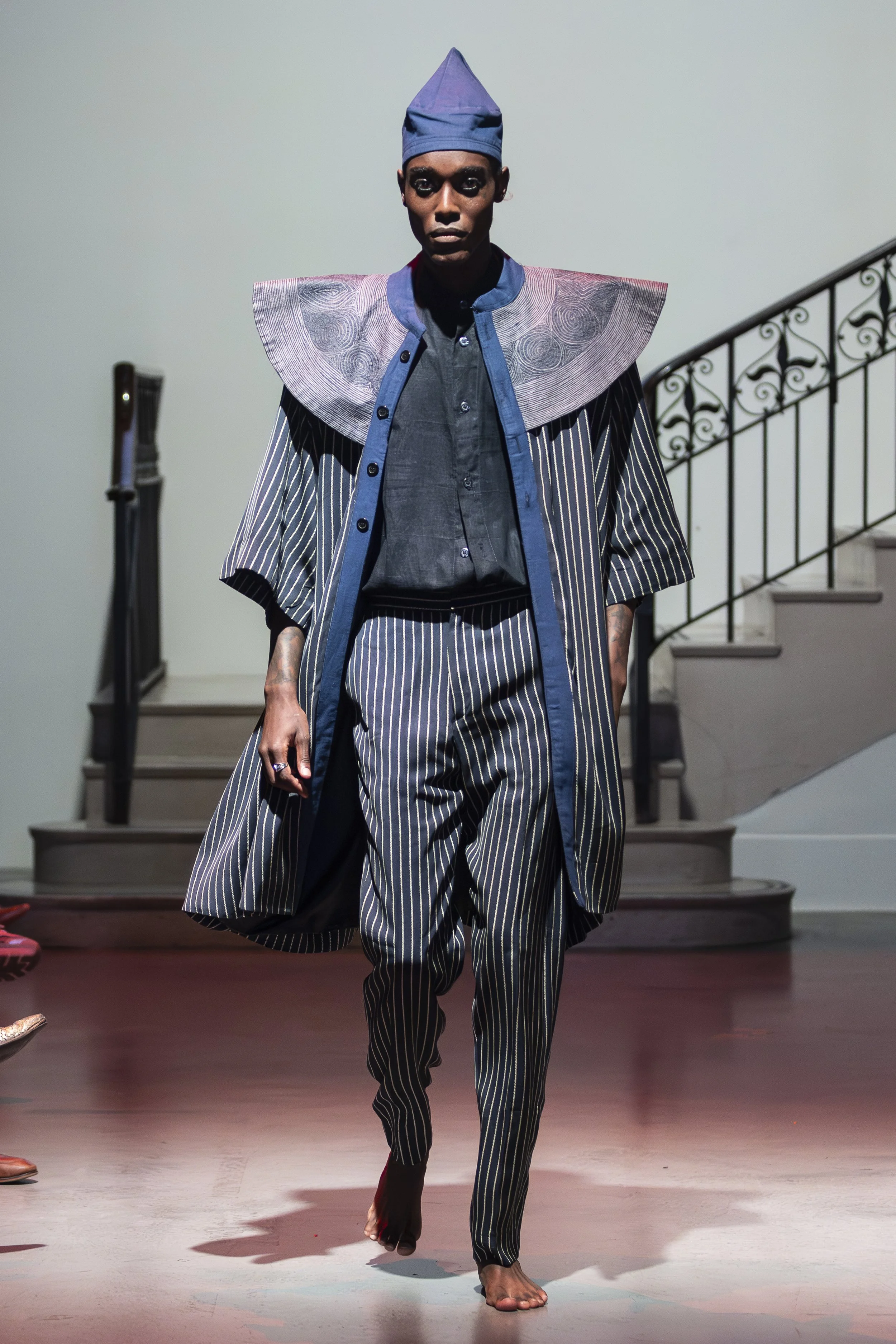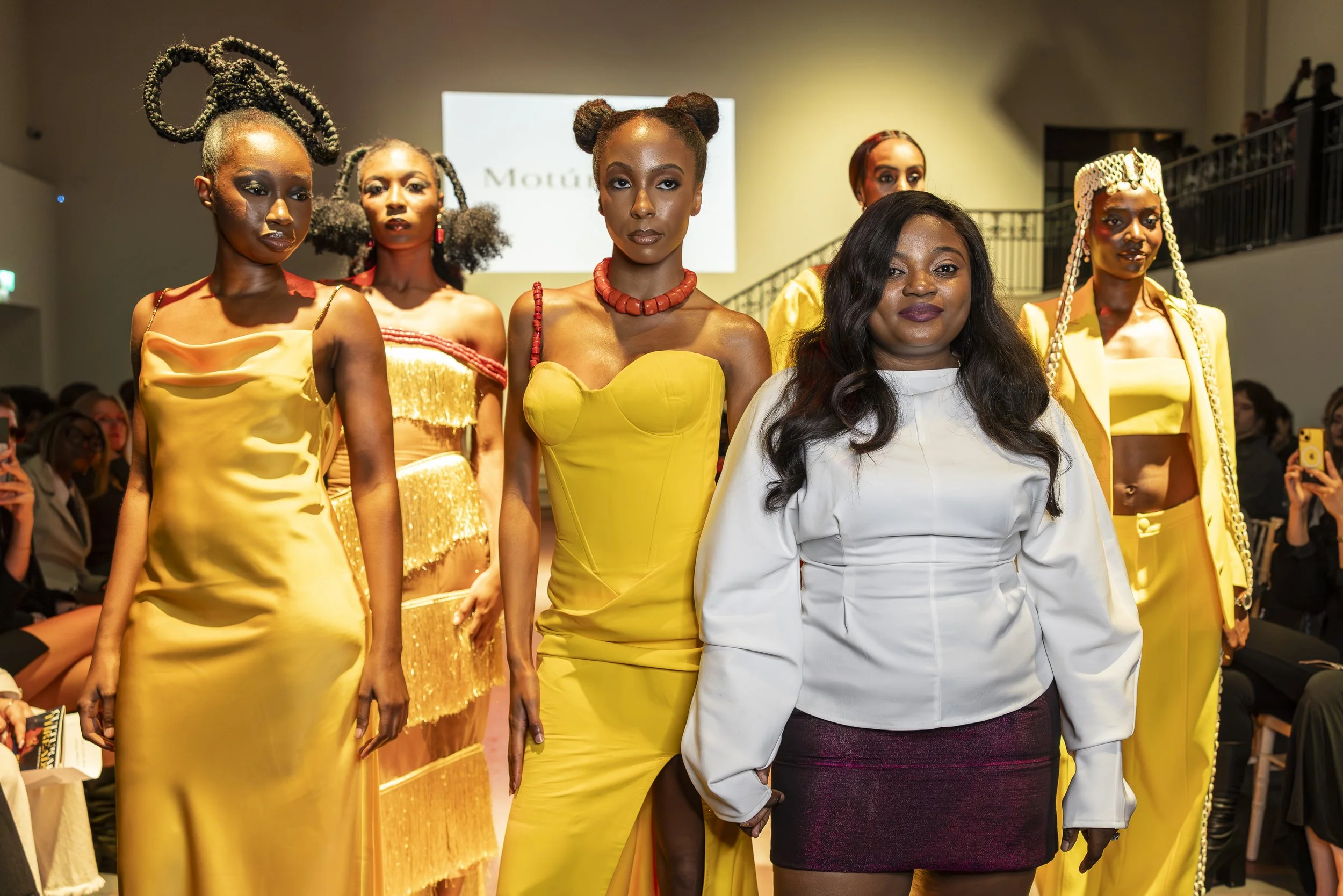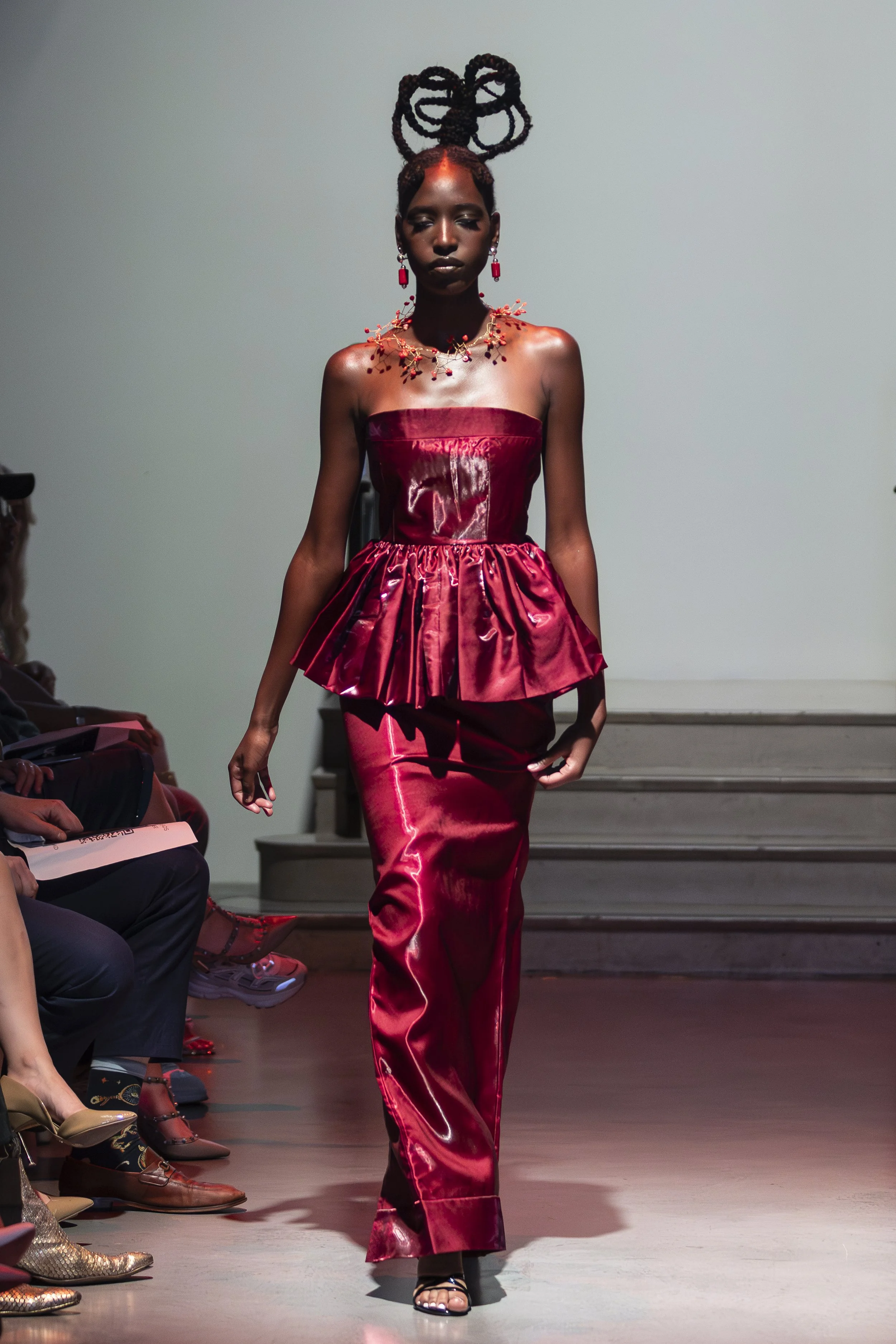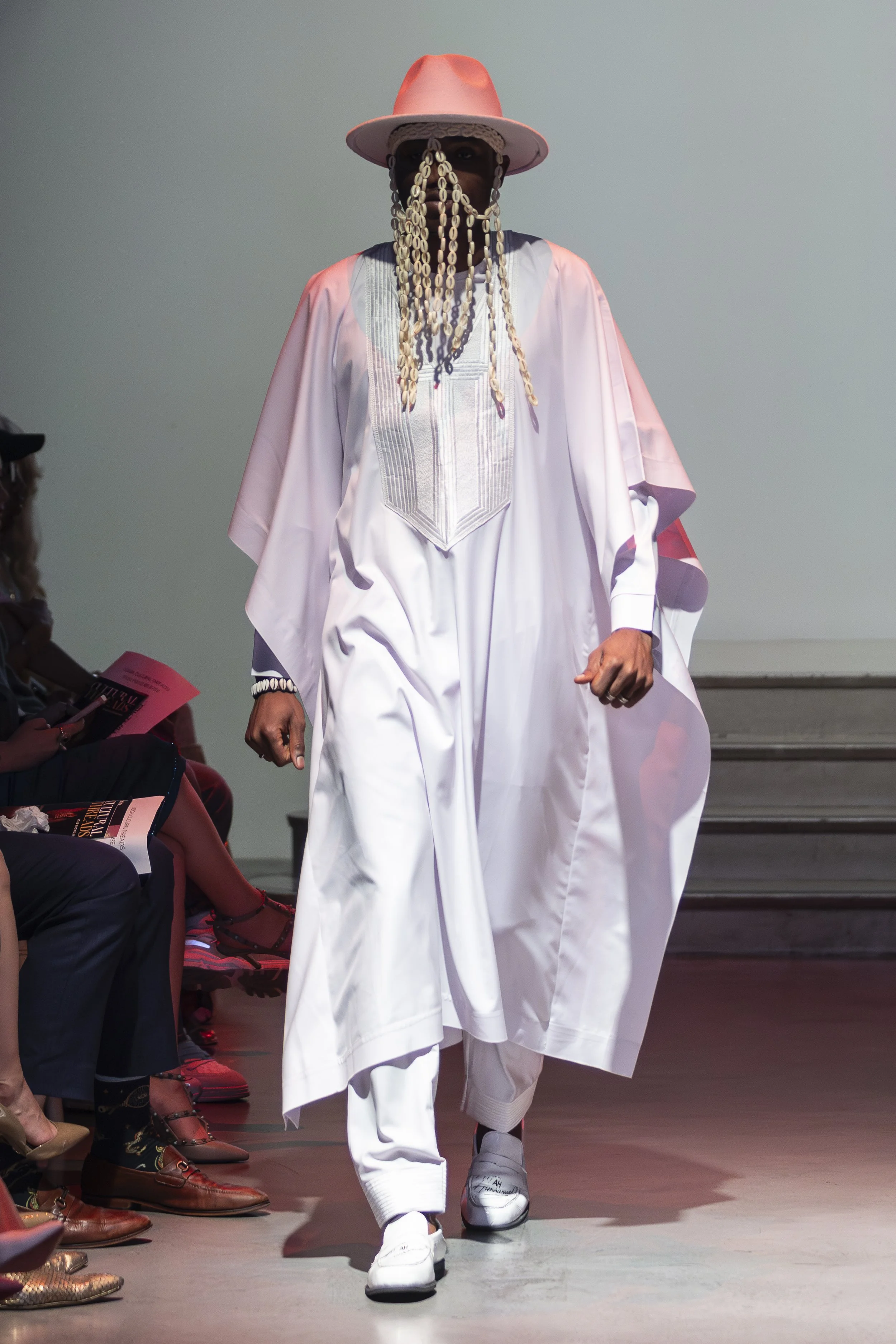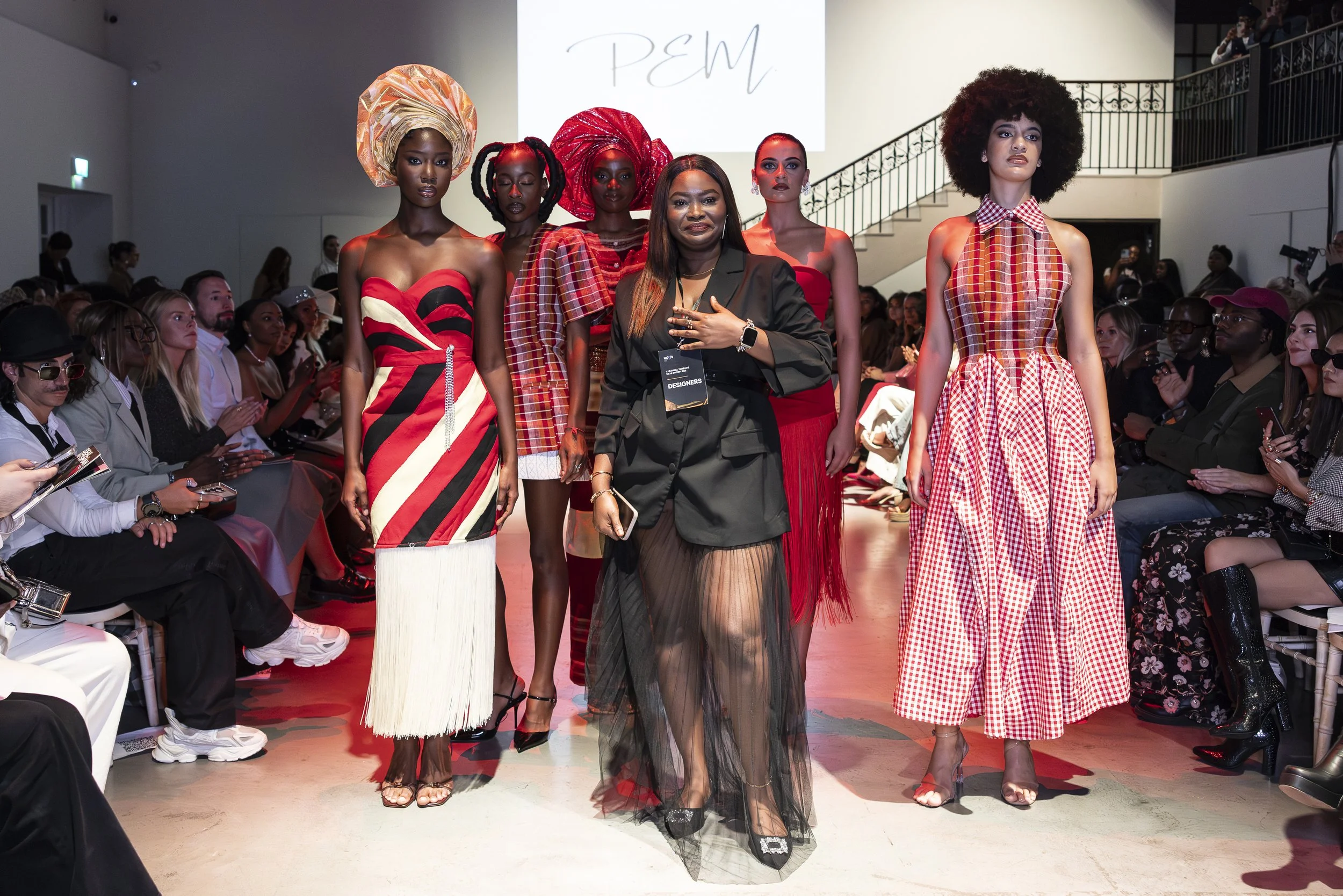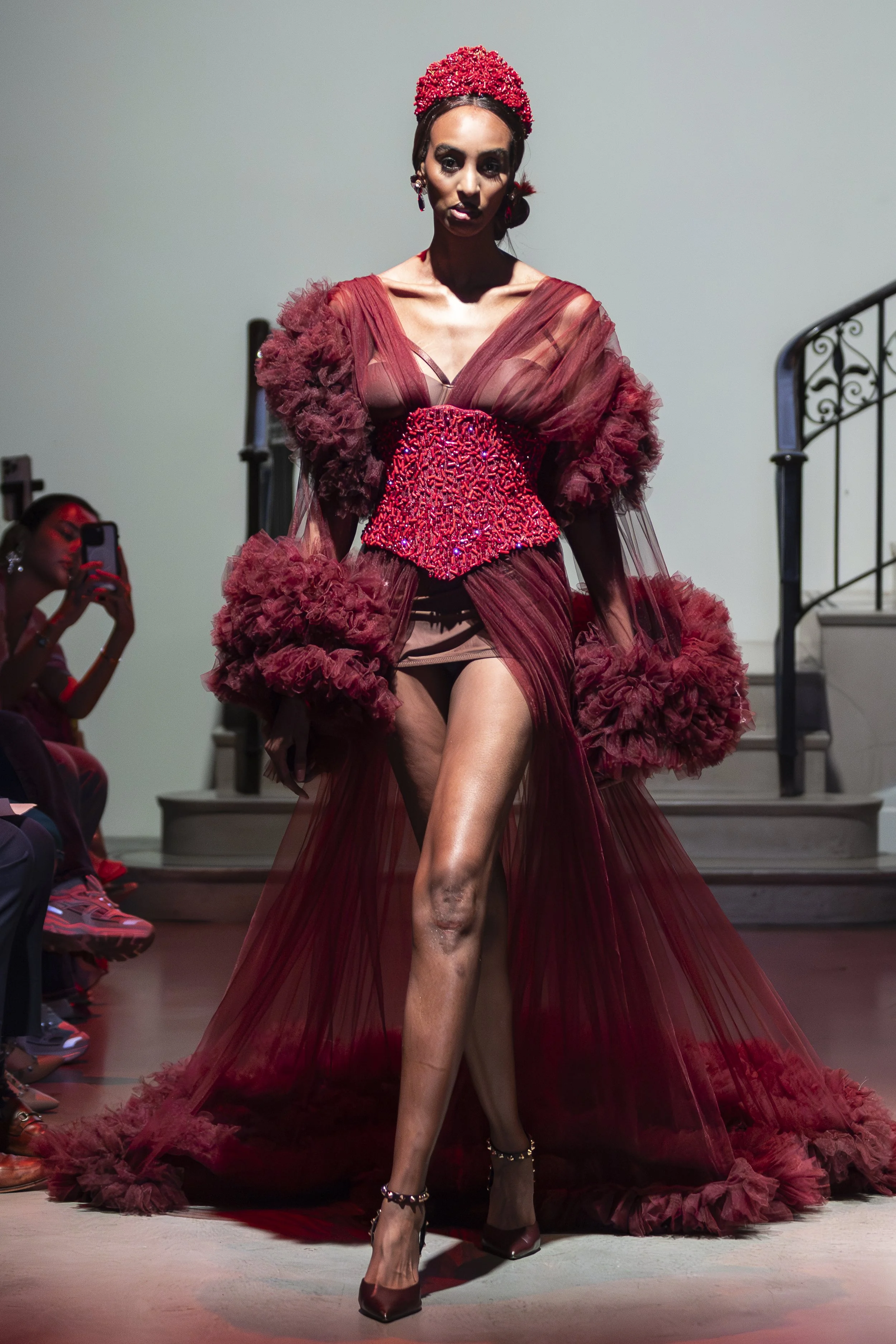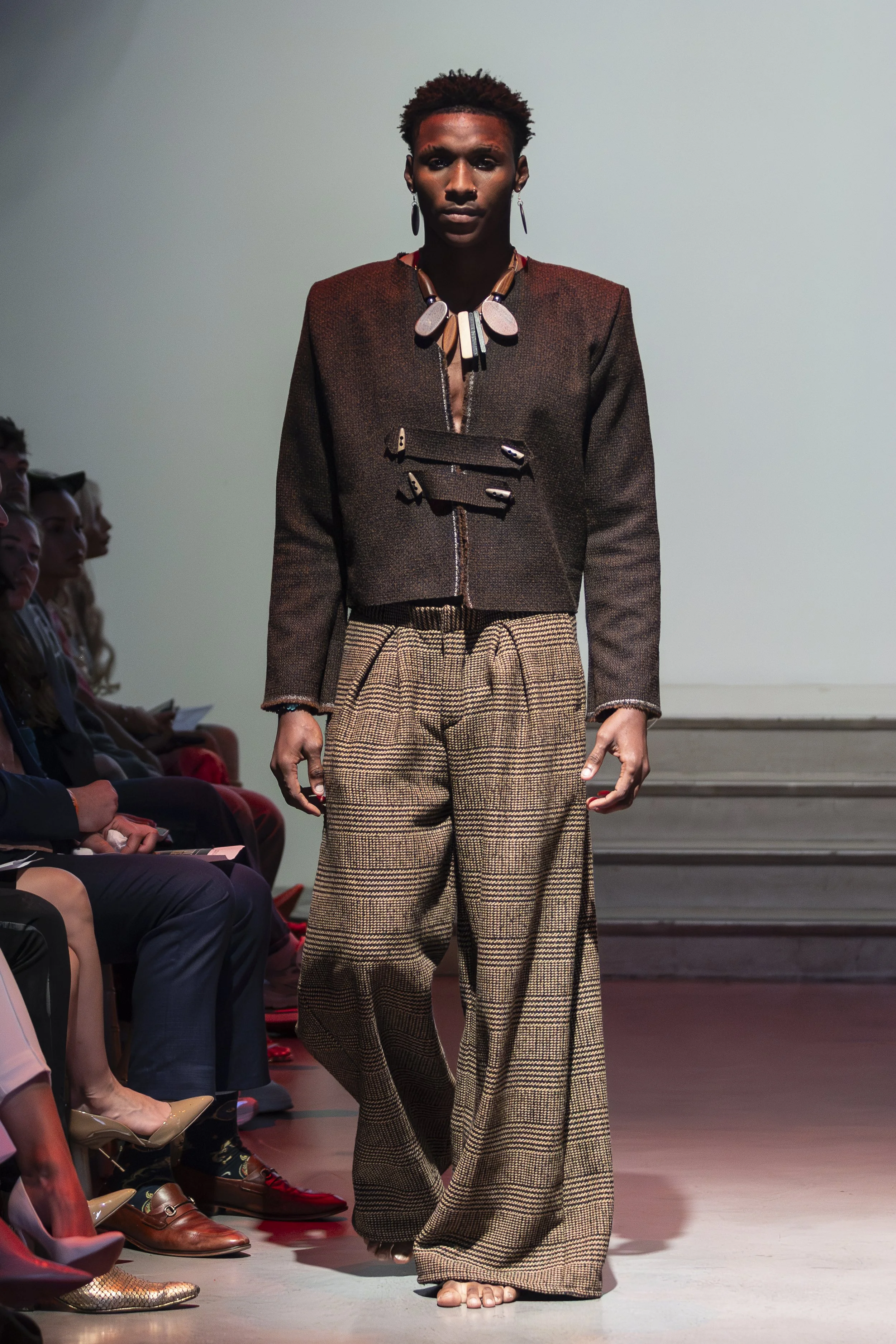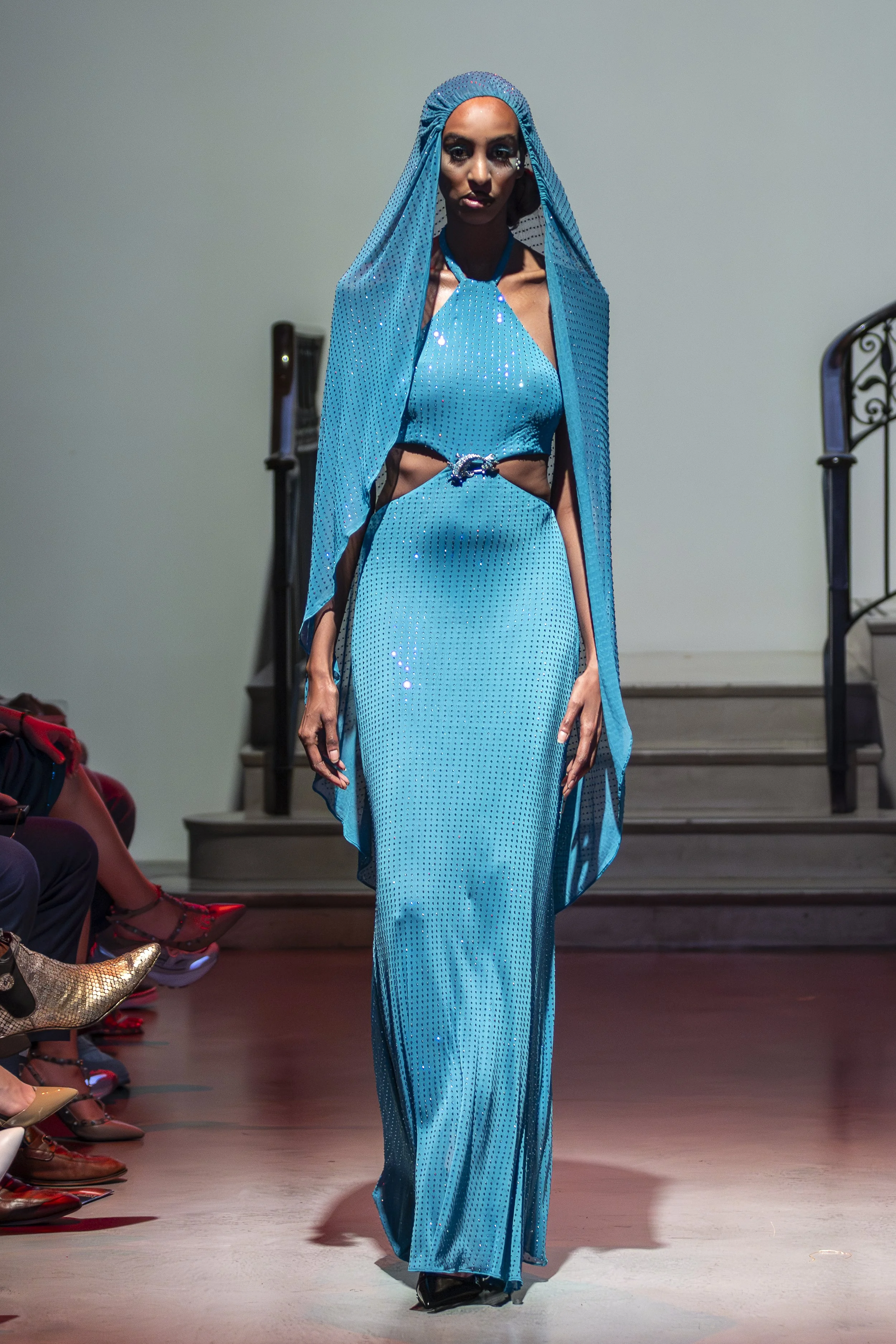‘Turning Struggles Into Legacy’: UDGN’s Cultural Threads Runway
Nancy Chizubere Johnson-Chidiadi’s ZUBERE collection
Ayah Ebimobowei Daukoru’s AYAH (collection The Fisherman’s Echo)
Histories and futures were woven together at Cultural Threads SS26, a runway staged by Unity in Design Global Network (UDGN) at London Fashion Week this September. Fusing African heritages with 21st-century techniques, the show soared beyond the usual trends and became an invocation of ritual and tradition.
‘My father’s words stay with me: you can walk alone, but to truly go forward you need a community,’ says Tare Isaac, the designer who founded UDGN this year. She explains that this organisation, which seeks to uplift minority designers and give African creatives a platform to collaborate and thrive, was ‘born from that conviction that our stories, our crafts, and our futures are strongest when they move together.’
‘UDGN is more than fashion, it’s about belonging,’ she says, adding that many designers like herself struggled with feeling invisible, unable to find recognition for their work. ‘This platform is our way of turning those struggles into legacy.’
‘My father’s words stay with me: you can walk alone, but to truly go forward, you need a community.’
(Omobolanle Sulleman’s BOLA (collection Inheritance)
But ‘invisible’ is the last word anyone would use to describe Cultural Threads. Ranging from pinstripe statements to beaded robes, these self-assured garments revealed makers who were confident in their design language and aesthetic philosophy. Each of the 14 designers featured contributed a uniquely coloured thread that became the full tapestry of this unforgettable LFW show.
Ayah Ebimobowei Daukoru’s AYAH (collection The Fisherman’s Echo):
On the Niger Delta’s muddy banks life is gritty and difficult, marked by the rhythms of the tides and the slow sweep of fishing nets. Polluted yet still beautiful, it’s a world evoked by Ayah Ebimobowei Daukoru’s collection The Fisherman’s Echo, created for his clothing brand Ayah. Sweeping kimonos and fishnet headpieces evoke a world by the riverside, while dyed cottons in palettes of moss green and smoky browns, alongside cowrie shells threaded through mesh layers ground these designs in the resilience of the Niger Delta’s inhabitants. Reflecting the endurance needed to survive and find beauty in this disintegrating ecosystem, it’s an atypical depiction of nature through a rugged, masculine lens.
Seyi Agboola’s ITELE (collection Freedom):
(Omobolanle Sulleman’s BOLA (collection Inheritance):
Aso-Oke, a hand-woven fabric used for centuries in Yoruba culture, is the cornerstone of Omobolanle Sulleman’s refined and minimalist collection Inheritance. Drawing from the majesty of the Ojude Oba Festival of Ijebuland, a festival honouring the Ijebu people’s traditional king, each item of clothing can be treated as an heirloom and passed down from mother to daughter. Not because they’re made of expensive materials but because their hand-made nature infuses them with luxury and festive joy. With a palette of navy, cornflower blue, and gold, the striped patterns of Sulleman’s designs shimmer like changing skies.
Each item of clothing can be treated as an heirloom passed down from mother to daughter.
Seyi Agboola’s ITELE (collection Freedom):
Omoyoloye Kolapo Ibiyinka’s KAYPEEFOOTWEARS (collection Apata):
This season, Seyi Agboola of Itele paired loafers with sunglasses and sleeveless t-shirts in a laid-back easy breezy style. The tops of his shoes are emblazoned with striking insignia, like stacks of dollar bills and golden bees, adding a dose of Pop Art flavour to the quintessentially British crafts of shoemaking and embroidery. The subversive spirit of these designs, which turn formal shoes into streetwear, echo Itele’s project of examining European colonial motifs through a contemporary Nigerian lens. With every footstep on the runway, Agboola’s collection stridently declares that the craftsmanship of African footwear can match—if not outdo—its European inspirations.
The craftsmanship of African footwear can match—if not outdo—its European inspirations.
Omoyoloye Kolapo Ibiyinka’s KAYPEEFOOTWEARS (collection Apata):
Southern Nigeria’s rain-weathered roads are walked by boys who become men through their journeys on foot. These exhausting pilgrimages are immortalised in Kolapo Omoyoloye’s love letter to Yoruba heritage, which enliven the business-like silhouettes of loafers and mules with unexpected pops of colour and decoration. Stripes of glowing yellow and saturated red are painted onto the leather of one pair, evoking the glow of torchlight.
Lekan Taofeek Folarin’s LEKAN AARE (collection Homage to the King)
Lekan Taofeek Folarin’s LEKAN AARE (collection Homage to the King):
Sleeves that fan out like butterfly wings and neutral palettes are complemented by bold accents of pin-striped royal blue fabric and beaded headdresses in this brand’s debut.
The bold stand more than justifies its name, which translates to ‘Homage of the King’. The sculpted geometries of this collection are accessorised by hats and beaded necklaces, borrowing from the familiar cut of corporate suits, but giving them a fresh splash of majesty in their dynamic shapes. It’s a playful blend of businesswear and ceremonial clothing that harnesses the regality of Yoruba tradition.
Olumide Oyewumi’s AFEFE ATI ILA collection for MIDETUSH LONDON
These are clothes tailor-made for a laidback summer evening; equally suited for London and Lagos.
Oyewunmi Olumide Kolapo’s MIDETUSH (collection Air & Stripes - Afefe Ati Awon Ila):
This season, the models radiated a breezy sense of comfort, as though strolling down a road, knowing that all eyes are on them. Olumide Oyewumi Kolapo’s streetwear collection draws on the sunniness of Lagos with oversized silhouettes that suggest infinite leisure, striped in refreshing yellows, blues, and tans. Cowrie shells, once used as currency, are a nod to tradition when used on collars and hats. These are clothes tailor-made for a laidback summer evening; equally suited for London and Lagos.
These designs combine playfulness and reverence.
Motunrayo Yetunde Ajayi’s MOTUNRAYO (collection Of Water and Spirit):
Like sunlight shining on honey, Motúnráyọ ̀’s collection Of Water and Spirit is unified by warm yellow tones that feel both lively and nuturing. Its designs feel like classic gowns and dresses from afar, but with exciting twists: a tailored yellow bandeau, trousers, and jacket is paired with a golden headdress with chains of shells draping down to the model’s sandalled feet. Taking inspiration from the Osun Festival and the iconography of the river goddess Oshun, these designs combine playfulness and reverence.
Motunrayo Yetunde Ajayi’s MOTUNRAYO (collection Of Water and Spirit)
Salami Oluwaseun Victoria’s OBIREEN (collection Okpa N Iyoba)
Salami Oluwaseun Victoria’s OBIREEN (collection Okpa N Iyoba):
A crucial power in the kingdom of Benin, Queen Idia was instrumental in helping ensure their unity at a time of war, counselling her son through political crises and receiving the title of iyoba (queen mother) for her role in ensuring victories. Idia’s legacy is celebrated in Salami Oluwaseun Victoria’s designs, where sultry crimson shades echo her vision of feminine might. From the lines of fitted bodices and grand ruffs, to the use of beadwork and fiery shades, inspired by Benin’s traditions of sacred coral beads), these garments are a rare chance for any woman to look and feel queenly.
These garments are a rare chance for any woman to look and feel queenly.
Yusuf Kareem Gbolahan’s OOMO AJADI (collection White Oracle - The Eko Spirit Walk)
Yusuf Kareem’s OOMO AJADI collection
Yusuf Kareem Gbolahan’s collection was a masterclass in minimalism with a profoundly symbolic foundation. The visage of angelic white was interrupted by the veils covering the faces of the models, giving tribute to masqueraders from Lagos Island, who act as mediators between the living and the divine. The shades of white and airy fabrics exude quiet dignity, and allow for the body to speak without words. Ritualistic simplicity transformed their show into a religious procession echoing centuries of culture.
The shades of white and airy fabrics exude quiet dignity, and allow for the body to speak without words.
Mary Princess Obeya’s PEM (collection The Spirit Wears Red - Iri Ogrinia):
Red ruled the runway in Mary Princess Obeya’s collection. Paying tribute to Idoma women, leaders, and dancers, the collection brings history to life with a red, beating heartbeat. Fringe, gingham, and bold patterns breathed movement and life into the show. Sacred attire was reframed through a contemporary lens.
Fiery flames of ancestral fire burnt as a tribute through the contrasting stripes, complementary checks, and solid swatches of burnt orange, rosy pink, and cherry red. The assertive presence of the ensembles commanded attention, while celebrating life itself.
Mary Princess Obeya’s PEM (collection The Spirit Wears Red - Iri Ogrinia)
Olaitan Maria Olatoke’s RBA (ROBES AND BLINGS BY AKOKOMALI) (collection Tiwa N Tiwa - Ours is Ours)
Olaitan Maria Olatoke’s RBA (ROBES AND BLINGS BY AKOKOMALI) (collection Tiwa N Tiwa - Ours is Ours):
Olaitan Maria Olatoke invites us into the bridal suite for a perusal into wedding-wear. Pristine cowries and delicate coral beads sparkled across the garments, offering more than beauty to the wearer, becoming almost talismans of protection for the queen they serve.
The glorious hues of a sheer red robe or a blush pink silk, as well as the reworked traditional white, call attention to the maiden of the hour.
Pristine cowries and delicate coral beads sparkled across the garments, offering more than beauty to the wearer, becoming almost talismans of protection for the queen they serve.
Olutoba Mercy Odetomi’s THE IDEAL CRAFTSMAN (collection The Five):
Olutoba Mercy Odetomi’s THE IDEAL CRAFTSMAN (collection The Five)
Once upon a time, in a city not too far away… tailored menswear was introduced to fantasy revivification through Olutoba Mercy Odetomi’s collection. The tailoring is exact, but the result demonstrates what a suit could be when reworked.
Via weighted bell sleeves, angular shoulders, facial jewellery and even a sword, the collection takes wardrobe staples and reimagines them with lashings of fantasy.
Many of the looks emphasised the whimsical, while still maintaining sharpness; some resembling day-wear for a Jedi, while others could be for a high-fashion businessman – who may or may not slay dragons in his spare time.
The collection takes wardrobe staples and reimagines them with lashings of fantasy. Many of the looks emphasised the whimsical, while still maintaining sharpness…
Tare Isaac’s TWIN BY TARE ISAAC (collection The Water Bearers):
As sure as waves flow in the sea, Twin by Tare Isaac presents a cool, fresh approach in connecting water, memory and womanhood in The Water Bearers.
Tare Isaac’s TWIN BY TARE ISAAC (collection The Water Bearers)
The line, which is inspired by the maternal line of the Ijaw people, includes a colour palette and textures that flowed down the runway like ripples in a river. With bejewelled gowns sparkling like sunlight on the water, or studded with shells and beads, the garments are contemporary works of art.
The fluidity of the silhouettes tie the past and future together.
Knotted details are reminiscent of the tying of cloth, a gesture symbolic in many African traditions, and a hooded veil suggests a play between spirituality and sensuality. The fluidity of the silhouettes tie the past and future together.
Nancy Chizubere Johnson-Chidiadi’s ZUBERE (collection Ulo Nwaanyi):
Nancy Chizubere Johnson-Chidiadi’s ZUBERE (collection Ulo Nwaanyi)
Nancy Chizubere Johnson-Chidiadi’s ZUBERE line connects to ancient roots to clothing that feels strikingly modern.
The movement of the ensembles was reminiscent of an Igbo bride’s magnificent entrance into a grand ceremony, taking the audience on a journey into this unique tradition.
Layered raffia and coral embellishments served as iconic symbols of strength, purity, and wealth, telling the story of both a bride and a queen.
The garments bridge the gap between heritage and reinvention, and help us look into a vibrant new wave of design.
The clothes also pay respect to matriarchal legacy through the confident, vibrant designs. The garments bridge the gap between heritage and reinvention, and help us look into a vibrant new wave of design.
All images supplied by Unity in Design Global Network and I.DEA PR



